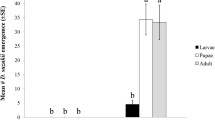Abstract
Twenty compounds identified in vulpia (Vulpia myuros) residues as allelochemicals were individually and collectively tested for biological activity. Each exhibited characteristic allelochemical behavior toward the test plant, i.e., inhibition at high concentrations and stimulation or no effect at low concentrations, but individual activities varied. Allelopathins present in large quantities, such as syringic, vanillic, and succinic acids, possessed low activity, while those present in small quantities, such as catechol and hydrocinnamic acid, possessed strong inhibitory activity. The concept of a phytotoxic strength index was developed for quantifying the biological properties of each individual allelopathin in a concise, comprehensive, and meaningful format. The individual contribution of each allelopathin, assessed by comparing the phytotoxic strength index to the overall toxicity of vulpia residues, was variable according to structure and was influenced by its relative proportion in the residue. The majority of compounds possessed low or medium biological activity and contributed most of the vulpia phytotoxicity, while compounds with high biological activity were in the minority and only present at low concentration. Artificial mixtures of these pure allelochemicals also produced phytotoxicity. There were additive/synergistic effects evident in the properties of these mixtures. One such mixture, formulated from allelochemicals found in the same proportions as occur in vulpia extract, produced stronger activity than another formulated from the same set of compounds but in equal proportions. These results suggest that the exploration of the relative composition of a cluster of allelopathins may be more important than simply focusing on the identification of one or two compounds with strong biological activity and that synergism is fundamental to the understanding of allelopathy.
Similar content being viewed by others
REFERENCES
AN, M. 1995. Allelopathy in vulpia residues. PhD thesis. Charles Sturt University, Wagga, Australia.
AN, M., PRATLEY, J. E., and HAIG, T. 1997a. Phytotoxicity of vulpia residues: I. Investigation of aqueous extracts. J. Chem. Ecol.23:1979-1995.
AN, M., PRATLEY, J. E., and HAIG, T. 1997b. Genotypic variation of plant species to the allelopathic effects of vulpia residues. Aust. J. Exp. Agric.37:647-60.
AN, M., PRATLEY, J. E., and HAIG, T. 2000. Phytotoxicity of vulpia residues: II. Separation, identification and quantitation of allelochemicals from Vulpia myuros. J. Chem. Ecol.26:1465-1476.
BELL, E. A., and CHARLWOOD, B. V. (eds.). 1980. Secondary Plant Products. Encyclopedia of Plant Physiology, New Series, Volume 8. Springer-Verlag, New York, 674 pp.
BLUM, U. 1995. The value of model plant-microbe-soil systems for understanding processes associated with allelopathic interactions: one example, pp. 127-131, inInderjit, K. M. M. Dakshini, and F. A. Einhellig (eds.). Allelopathy: Organisms, Processes, and Applications, ACS Symposium Series 582. American Chemical Society, Washington, D.C.
BLUM, U., DALTON, B. R., and SHANN, J. R. 1985. Effects of various mixtures of ferulic acid and some of its microbial metabolic products on cucumber leaf expansion and dry matter in nutrient culture. J. Chem. Ecol.11:619-641.
BLUM, U., SHAFER, S. R., and LEHMAN, M. E. 1999. Evidence for inhibitory allelopathic interactions involving phenolic acids in field soils: Concepts vs. an experimental model. Crit. Rev. Plant. Sci.18(5):673-693.
EINHELLIG, F. A. 1986. Mechanisms and modes of action of allelochemicals, pp. 171-188, inA. R. Putnam and C. S. Tang (eds.). The Science of Allelopathy. John Wiley & Sons, New York.
EINHELLIG, F. A. 1987. Interactions among allelochemical and other stress factors of the plant environment, pp. 343-357, inG. R. Waller (ed.). Allelochemicals: Role in Agriculture and Forestry. ACS Symposium Series 330. Americal Chemical Society, Washington, D.C.
EINHELLIG, F. A. 1989. Interactive effects of allelochemicals and environmental stress, pp. 101-118, inC. H. Chou and G. R. Waller (eds.). Phytochemical Ecology: Allelochemicals, Mycotoxins and Insect Pheromones and Allomones. Academia Sinica Monograph Series NO. 9. Taipei, Taiwan.
FUERST, E. P., and PUTNAM, A. R. 1983. Separating the competitive and allelopathic components of interference: Theoretical principles. J. Chem. Ecol.9:937-944.
GRIME, J. P. 1979. Plant Strategies and Vegetation Processes. Wiley, Chichester, U.K.
HARBORNE, J. B. 1997. Role of phenolic secondary metabolites in plants and their degradation in nature, pp. 67-74, inG. Cadisch and K. E. Giller (eds.). Driven by Nature, Plant Litter Quality and Decomposition. CAB International, Wallingford.
INDERJIT, and MALLIK, A. U. 1997. Effect of phenolic compounds on selected soil properties. For. Ecol. Man.92:11-18.
PUTNAM, A. R., and TANG, C. S. 1986. The Science of Allelopathy. John Wiley & Sons, New York, 317 pp.
RASMUSSEN, J. A., and EINHELLIG, F. A. 1977. Synergistic inhibitory effects of p-coumaric and ferulic acids on germination and growth of grain sorghum. J. Chem. Ecol.3:197-205.
RICE, E. L. 1984. Allelopathy, 2nd ed. Academic Press, New York, 421 pp.
RICE, E. L. 1985. Allelopathy-an overview, pp. 81-105, inG. A. Cooper-Drive, T. Swain and E. E. Conn (eds.). Recent Advances in Phytochemistry: Chemically Mediated Interaction Between Plants and Other Organisms. Plenum Press, New York.
WILLIAMS, R. D., and HOAGLAND, R. E. 1982. The effects of naturally occurring phenolic compounds on seed germination. Weed Sci.30:206-212.
WILLIS, R. J. 1985. The historical bases of the concept of allelopathy. J. Hist. Biol.18:71-102.
Author information
Authors and Affiliations
Rights and permissions
About this article
Cite this article
An, M., Pratley, J.E. & Haig, T. Phytotoxicity of Vulpia Residues: III. Biological Activity of Identified Allelochemicals from Vulpia myuros. J Chem Ecol 27, 383–394 (2001). https://doi.org/10.1023/A:1005640708047
Issue Date:
DOI: https://doi.org/10.1023/A:1005640708047




